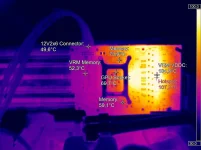New NVIDIA RTX 50 cards show troubling heat problems on their backs. Tests from Igor's Lab found temperatures over 100°C near power delivery parts even when the main chip stays below 80°C. These hot areas appear because heat builds up in thin copper layers inside the circuit board. Graphics card makers Palit, PNY, and MSI all face similar issues since they follow NVIDIA's designs closely. The problem stems from separate teams working on circuit boards and cooling systems without enough coordination.
NVIDIA gives partners detailed guides about heat management that assume perfect lab conditions. Real computers at home behave differently. Circuit boards force electricity through very thin copper paths that connect through tight spots under power parts. Without special cooling bridges, these areas trap heat that standard cooling methods cannot remove fast enough. The problem affects older cards as well. Even the RTX 4090, with its massive cooling system, showed hot spots on prototype boards where areas near power parts reached mid-70s Celsius while the main chip stayed in the low-60s.
Card makers thought standard cooling would work because NVIDIA's guide didn't highlight these trouble spots. Simple fixes can help solve the problem. Adding thin thermal pads between hot areas and the metal backplate lowered peak temperatures by 8 to 12°C in tests. This easy change could improve card reliability and performance for many users with minimal cost or design changes.
NVIDIA gives partners detailed guides about heat management that assume perfect lab conditions. Real computers at home behave differently. Circuit boards force electricity through very thin copper paths that connect through tight spots under power parts. Without special cooling bridges, these areas trap heat that standard cooling methods cannot remove fast enough. The problem affects older cards as well. Even the RTX 4090, with its massive cooling system, showed hot spots on prototype boards where areas near power parts reached mid-70s Celsius while the main chip stayed in the low-60s.
Card makers thought standard cooling would work because NVIDIA's guide didn't highlight these trouble spots. Simple fixes can help solve the problem. Adding thin thermal pads between hot areas and the metal backplate lowered peak temperatures by 8 to 12°C in tests. This easy change could improve card reliability and performance for many users with minimal cost or design changes.












